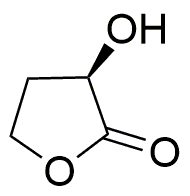(R)-(+)-a-Hydroxy-g-butyrolactone is widely utilized in research focused on
- Pharmaceutical Development: This compound serves as an important intermediate in the synthesis of various pharmaceuticals, particularly in the production of anti-inflammatory and analgesic drugs, enhancing their efficacy and reducing side effects.
- Biodegradable Polymers: It is used in the formulation of biodegradable polymers, which are increasingly important in reducing plastic waste. These polymers find applications in packaging, medical devices, and agricultural films.
- Cosmetic Formulations: The compound is incorporated into cosmetic products for its moisturizing and skin-conditioning properties, making it a popular choice in creams and lotions aimed at enhancing skin hydration.
- Food Industry: It acts as a food additive, providing flavoring and preservation benefits. Its use in food products helps improve shelf life while maintaining taste quality.
- Research Applications: In academic and industrial research, it is utilized as a chiral building block for synthesizing complex organic molecules, aiding in the development of new materials and chemical processes.
General Information
Properties
Safety and Regulations
Applications
(R)-(+)-a-Hydroxy-g-butyrolactone is widely utilized in research focused on
- Pharmaceutical Development: This compound serves as an important intermediate in the synthesis of various pharmaceuticals, particularly in the production of anti-inflammatory and analgesic drugs, enhancing their efficacy and reducing side effects.
- Biodegradable Polymers: It is used in the formulation of biodegradable polymers, which are increasingly important in reducing plastic waste. These polymers find applications in packaging, medical devices, and agricultural films.
- Cosmetic Formulations: The compound is incorporated into cosmetic products for its moisturizing and skin-conditioning properties, making it a popular choice in creams and lotions aimed at enhancing skin hydration.
- Food Industry: It acts as a food additive, providing flavoring and preservation benefits. Its use in food products helps improve shelf life while maintaining taste quality.
- Research Applications: In academic and industrial research, it is utilized as a chiral building block for synthesizing complex organic molecules, aiding in the development of new materials and chemical processes.
Documents
Safety Data Sheets (SDS)
The SDS provides comprehensive safety information on handling, storage, and disposal of the product.
Product Specification (PS)
The PS provides a comprehensive breakdown of the product’s properties, including chemical composition, physical state, purity, and storage requirements. It also details acceptable quality ranges and the product's intended applications.
Certificates of Analysis (COA)
Search for Certificates of Analysis (COA) by entering the products Lot Number. Lot and Batch Numbers can be found on a product’s label following the words ‘Lot’ or ‘Batch’.
*Catalog Number
*Lot Number
Certificates Of Origin (COO)
This COO confirms the country where the product was manufactured, and also details the materials and components used in it and whether it is derived from natural, synthetic, or other specific sources. This certificate may be required for customs, trade, and regulatory compliance.
*Catalog Number
*Lot Number
Safety Data Sheets (SDS)
The SDS provides comprehensive safety information on handling, storage, and disposal of the product.
DownloadProduct Specification (PS)
The PS provides a comprehensive breakdown of the product’s properties, including chemical composition, physical state, purity, and storage requirements. It also details acceptable quality ranges and the product's intended applications.
DownloadCertificates of Analysis (COA)
Search for Certificates of Analysis (COA) by entering the products Lot Number. Lot and Batch Numbers can be found on a product’s label following the words ‘Lot’ or ‘Batch’.
*Catalog Number
*Lot Number
Certificates Of Origin (COO)
This COO confirms the country where the product was manufactured, and also details the materials and components used in it and whether it is derived from natural, synthetic, or other specific sources. This certificate may be required for customs, trade, and regulatory compliance.


